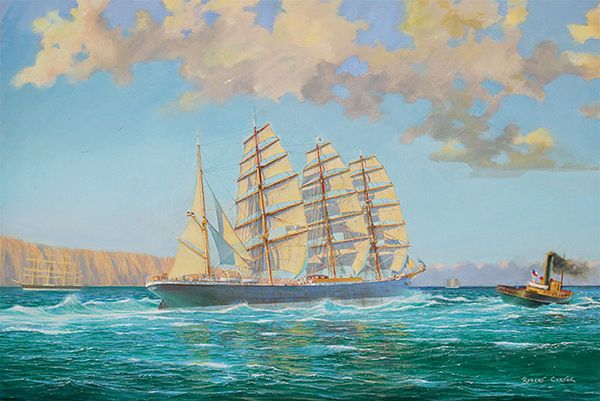Peking – Leaving Iquique by Robert Carter
Robert is one of Australia's leading marine artists and is also joint founder of the Australian Society of Marine Artists with Dean Claflin.1 You can read more about Bob's biographical information by clicking here.
In The Marine Paintings of Robert Carter Bob has presented his paintings in five parts2 and we follow this same format. We are up to Part Four: German Sail and French Ships where the ships painted by Robert illustrate that While Britain led the world in shipbuilding in the nineteenth century it was Germany, and to a lesser extent France, that took the sailing ship into the twentieth century.2
If you missed the last post in this series click here.
Today we showcase four-masted barque Peking.

It is 1913 and the 4-masted barque Peking puts to sea with 60000 bags of sodium nitrate in her belly, heading towards Hamburg, her home port.
Peking was built by Blohm & Voss for the firm of F. Laeisz; a German shipping company, which had considerable interests in South America, particularly Chile and the nitrates that were mined there.
Peking was built in 1911, along with Passat, at a time when the building of large steel sailing ships had ceased in other countries. Laeisz went on to order three more similar sailing ships: Pola 1916, Priwall 1917 and Padua 1926. All Laeisz ships were built to the same high specifications – which included steel masts and yards, double cap stays, triple topmast backstays, double jackstays, wire buntlines and balanced rudders. The Jarvis brace winch (designed in Great Britain) was adopted for all their vessels.
Laeisz ships were all built to a similar design and Peking and Passat were true sisters, being built from the same hull plan, although there were small differences in deck layout and rigging.
When WW1 started, Peking was in Valparaiso and was interned. On returning to Germany at war’s end she was given to Italy in 1920 as reparations . Italy had no use for her and Laeisz bought her back in 1923.
They returned her to the nitrate run but the introduction of synthetic nitrates in the late ’twenties made this trade unprofitable. In 1932 she was sold to Shaftsbury Homes. This was a British institution that provided education and seamanship training for under privileged boys. She was moored in the Medway, partly rigged down and modified below deck to accommodate a large number of boys. She was renamed Arethusa after an old wood frigate of the same name that had been used for the same purpose.3
Restoration
In 1975 a New York syndicate bought her for exhibition at South Street Maritime Museum. She was re-rigged but restoration was slow and in 2017 she was bought by a German syndicate and taken back to Hamburg on a heavy lift ship. Full refurbishment is now taking place.3
© Thank you to Robert Carter who kindly gave permission for the image of his work to be shared on AnArt4Life.
Please check out the Robert Carter Website.
And also the site for the Marine Artisits Australia.
Tomorrow we continue with our vintage transport posts when Julie has an interesting story about the restoration of the famous Southern Cross flown by Charles Kingsford Smith and Charles Ulm.
The next glorious vessel in our Robert Carter Marine Series will appear very soon.
Credits
1. Correspondence with Robert Carter
2. The Marine Paintings of Robert Carter, Published in Australia by Robert Carter Maritime, Gosforth NSW, 2320, Australia, 2022
3. robertcarter.com.au
